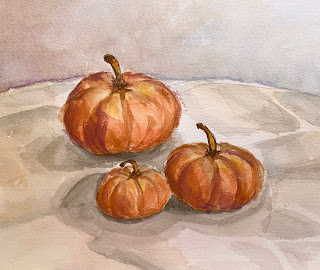I need to get outside or my brushwork gets too fussy.
 |
| Harkness Brook, oil on canvas with a splotch or two of snow, by Carol L. Douglas. |
After I taught in Tallahassee in November, it took me a few weeks to acclimate myself to the temperature here in Maine. I expected that. I didn’t expect the same thing when I got home from Wyoming this week. It was warmer than usual there, and now the entire country has settled into the winter deep freeze.
Here in Maine, I usually spend a few hours a day outside. At dawn I hike up to the summit of Beech Hill. That gets the blood flowing for the day. At midday I go out again, either to the post office or on another off-road hike. I almost always get my 10,000 steps in without being aware that I’m ‘exercising’ or that it’s cold outside.
 |
| The wind-sculpted summit of Beech Hill. |
But after I’ve been on the road, I’m always miserable the first few days back. “My everything hurts,” I complained yesterday. I’d been sitting behind the wheel of my new truck for a week, driving. At my age, I decondition far more quickly than I did at twenty.
My limit for sustained outdoor activity is 10°F. Below that, it’s just too much work to stay warm. Luckily, I live right on the coast, where extreme cold is unusual. That ocean just beyond my backyard acts like a massive heatsink, cooling us in the summer and warming us in the winter.
 |
| Snow at Highter Elevations (Downdraft Snow) by Carol L. Douglas |
But I can be fooled, as I was on Monday. The nominal temperature was in the teens, but as I rounded the summit, I was hit square in the face by a bitter wind. The wind often picks up as the sun rises, and this one was fierce. By the time we were back to the car, even my little dog—seemingly impervious to the cold—was acting chilled.
Still, the snow is beautiful, hanging on every evergreen branch. “You want to paint?” I texted a few of my buddies. Only Ken DeWaard was foolish enough to agree. Dressed in my long underwear, mittens, neck gaiter, heavy jacket, and hardiest boots, I drove out to meet him. It was absolutely awful, but we both did sketches that we liked. Meanwhile, Eric Jacobsenwas painting near the top of Beech Hill, and he did a fine painting. There’s a lesson in that, I think. Sometimes you really do have to suffer for your art.
Meanwhile, it’s continued to snow, and the temperature continues to drop. I’m looking out at the gloaming wondering if I want to go out to paint again today. It all depends on the light.
Why do we do this, when we each have nice, toasty-warm studios in which we can paint? One paints differently in the studio from in the field. I need regular days of painting from life so that I remember what life looks like when I paint from photos. Without that, my brushwork gets too fussy.
Postscript: my student Yvonne Bailey posted the above photo on Facebook. She had rearranged her furniture and swapped her dogs’ crates around. Creatures of habit, they both insisted on returning to where they thought they belonged. There’s a lesson in that for us as well: it’s easy for us humans to get overly attached to our ‘places’. Habit is good, but it can become a rut.







